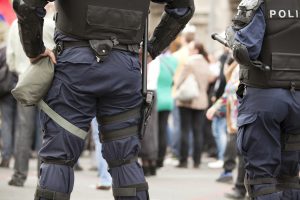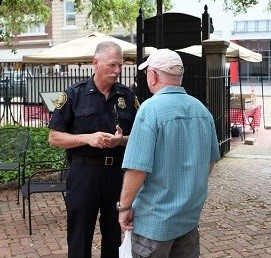Intelligence-Led Policing: Preferred Policing Model in the War Against Terrorism

By – Dr. Michael L. Beshears
In the United States, law enforcement officers are charged with helping in the fight against terrorism while simultaneously safeguarding the individual constitutional rights of those they have sworn to protect and serve.
Police face threats on many levels, from local to international. Global threats, such as the ones demonstrated by the terrorist events in Paris and most recently in Brussels, were well-coordinated attacks by suicide bombers and gunmen who killed and wounded hundreds of civilians.
Policing Model Options to Fight Terrorism
According to policing scholar Willard Oliver (2009), “Since the terrorist attack of September 11, 2001, federal, state and local governments have increasingly moved toward establishing homeland security as an institutional response to not only the threat of future terrorist attacks but as a means of preparing and responding to natural disasters.” This was made clear when then-President George W. Bush said, “Countering and investigating terrorist activity is the number one priority for both law enforcement and intelligence agencies” (Stewart & Morris, 2009).
Scholars and police departments were now faced with determining the best way to handle their new homeland security responsibilities. How would these new responsibilities affect the traditional policing philosophy of protecting and serving the community while simultaneously safeguarding individuals’ constitutional rights?
Scholarly literature suggests there are two primary policing models that are relevant to law enforcement officers and the fight against terrorism.
Israeli Policing Model
The first is the Israeli Model for Policing Terrorism, which emphasizes the role of local police agencies in collecting intelligence on terrorist networks, apprehending terror operatives, and protecting likely targets. For example, the Israeli Police work to prevent acts of terror by conducting patrols, raids, as well as working to increase public awareness. The positive benefit of this model is that the citizens of Israel, over time, have become more aware of their surroundings and possible terroristic threats. For example, Israeli citizens are educated by the police to be cautious and to report any item left unattended in a public setting that may possibly contain an explosive device.
Such potential explosives include the pressure-cooker bombs that exploded near the finish line of the 2013 Boston Marathon. Allegedly, these bombs were concealed in two unattended black nylon padded knapsacks or duffel bags. Regrettably, as a result of the explosions, several people were killed and other bystanders and race participants were seriously injured. Perhaps this tragic event may have been prevented had public awareness been heightened by law enforcement to report unattended bags, as put forth in the Israeli Model.
While the Israeli policing model has proven to be effective, there is skepticism about how this style of policing would be received by citizens in the United States. In Israel, this style of policing has led to an ongoing tension between the public and the Israeli police force.
According to a 2014 RAND Corporation report, “Even with relatively low crime rates, the public in Israel perceives an increasing threat to personal security and concern over the quality of police service.” Perhaps the ongoing tensions between the public in Israel and the Israeli police can be attributed to the fact that police are a national law enforcement force with national jurisdiction. This is unlike the United States, where law enforcement powers are based on federalism, which creates both federal and state law enforcement agencies. In Israel, there is only one national all-encompassing police agency with total jurisdiction, similar to a military force. This may add to the public perception that Israeli police are distanced from addressing local community concerns or needs, which is heightened by the fact that Israeli police are more focused on terrorism-related crimes than local crime and efforts to build positive community relationships.
Additionally, some citizens may feel threatened or fearful when they observe or encounter police officers wearing paramilitary-style police uniforms. An appearance and demeanor that some citizens feel do not convey partnership or collaboration with the public. This is a reasonable concern as studies similar to the Milgram and Stanford Prison Experiment show that wearers of these kinds of uniforms may begin to act the way they perceive a wearer of such a uniform should act. This is known as deindividuation. In other words, it is believed that police officers wearing a paramilitary-style uniform on the job may be inclined to display unnecessary militaristic and aggressive behaviors in the performance of their duties.
Intelligence-Led Policing

Intelligence-led policing, on the other hand, is a policing model that has more ties to community policing and community-oriented policing strategies, which have been used in the United States for the past three or four decades. Perhaps this is why in the United States the Intelligence-Led Policing Model is emphasized in the fight against terrorism more so than the Israeli policing model.
The intelligence-led policing model focuses more on working collaboratively with the public. In order for intelligence-led policing to be successful in gathering actionable intelligence, officers on the street must work to build close relationships with community members as well as share that information with other agencies. For example, when looking at combating street crimes (such as burglary or robbery) one community may have three home robberies within a week. A neighboring community, county, or state might have five or six similar burglaries within the same period of time or shortly thereafter. Information obtained from local residents and crime scene investigators about those crimes needs to be shared within departments as well as with other local, state, and federal agencies. The similarities pertaining to the various crime scenes are then analyzed using strategic and tactical analysis.
Data that has been thoroughly analyzed via strategic and tactical analysis benefits police officers and investigators because it allows them to be more productive with their time. The reports furnished by analysts provide insight into where a crime, or a possible terrorist event, is more likely to occur or reoccur (i.e. geographically pertaining to location, as well as a potential time of day). These predictions are then shared within the law enforcement community and various federal agencies to apprehend or deter criminals and/or terrorists from targeting a specific location.
According to the International Association of Chiefs of Police (as cited by, Chappell & Gibson, 2009), “community policing is a necessary component of homeland security.” Local police must work hand-in-hand with citizens to gather information in order to generate useful intelligence. Understanding the need to have a close relationship with the local community enhances law enforcement’s ability to obtain needed intelligence to identify pre-incident terrorism indicators.

About the Author: Dr. Michael L. Beshears since military retirement has acquired over 20 years of teaching experience in the traditional and online teaching environment. Michael has an extensive background and first-hand experience in online pedagogy and andragogy instruction, as one of the first Internet (online) course developers and instructors. Since 1994, he has instructed more than 30,000 online students and mentored numerous colleagues in the skills required to instruct online while promoting student success. Michael is a co-adviser for the Kappa-Kappa Chapter of the Alpha Phi Sigma – Criminal Justice National Honor Society.
Michael has two baccalaureate degrees, one in psychology and another in criminal justice from Drury University. In addition, he has two graduate degrees, one in criminology from Indiana State University and another in health services management from Webster University. Michael also has a Ph.D. in business administration with a specialization in criminal justice from Northcentral University. He is currently an assistant professor of criminal justice at American Military University and is full-time faculty in the school of Security and Global Studies. First Published – In Public Safety with American Military University
References
Chappell, A. T. & Gibson, S. A. (2009). Community Policing and Homeland Security Policing: Friend or Foe?Criminal Justice Policy Review 2009; 20; 326 originally published online Mar 12, 2009; doi: 10.1177/0887403409333038
McGarrell, E. F., Freilich, J. D. & Chermak, S. (2007). Intelligence-Led Policing as a Framework for Responding to Terrorism. Journal of Contemporary Criminal Justice 2007; 23; 142. doi: 10.1177/1043986207301363
Oliver, W. M. (2009). Policing for homeland security policy & research. Criminal justice policy review, 20(3), 253-260.
Saunders, J., Popper, S.W., Morral, A.R., Davis, R.C., Berrebi, C., Leuschner, K.J., Efron, S., Segalovitz, B., & Riley, K.J. [RAND REPORT] (2014). Effective Policing for 21st-Century Israel, RAND Corporation. ISBN: 978-0-8330-8508-5
Stewart, D. M. & Morris, R. G. (2009). A New Era of Policing: An Examination of Texas Police Chiefs’ Perceptions of Homeland Security. Criminal Justice Policy Review 2009; 20; 290. doi: 10.1177/0887403408337225

